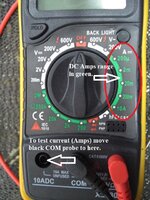I'm thinking of buying a multimeter to do a battery test on my engine battery to see what's causing it to lose power 3 days after charging, i.e. by testing the power being drawn and pulling out fuses to identify the culprit.
Looking online it seems you can pay anything from £8 to £160. Some of the cheaper multimeters seem to have a maximum of 10 amps (assuming I've understood their purpose correctly) but some of the fuses on the Fiat are for 20 amps. Can someone recommend one that covers 20 amps at a reasonable price, e.g. up to say £50.
Looking online it seems you can pay anything from £8 to £160. Some of the cheaper multimeters seem to have a maximum of 10 amps (assuming I've understood their purpose correctly) but some of the fuses on the Fiat are for 20 amps. Can someone recommend one that covers 20 amps at a reasonable price, e.g. up to say £50.




